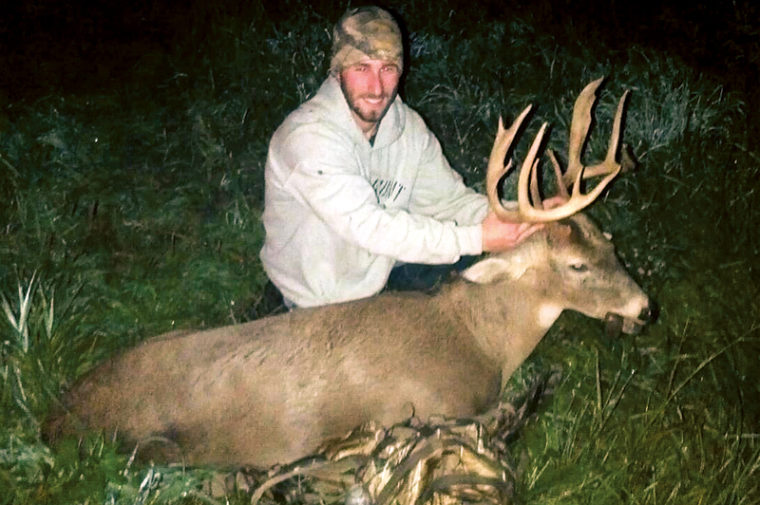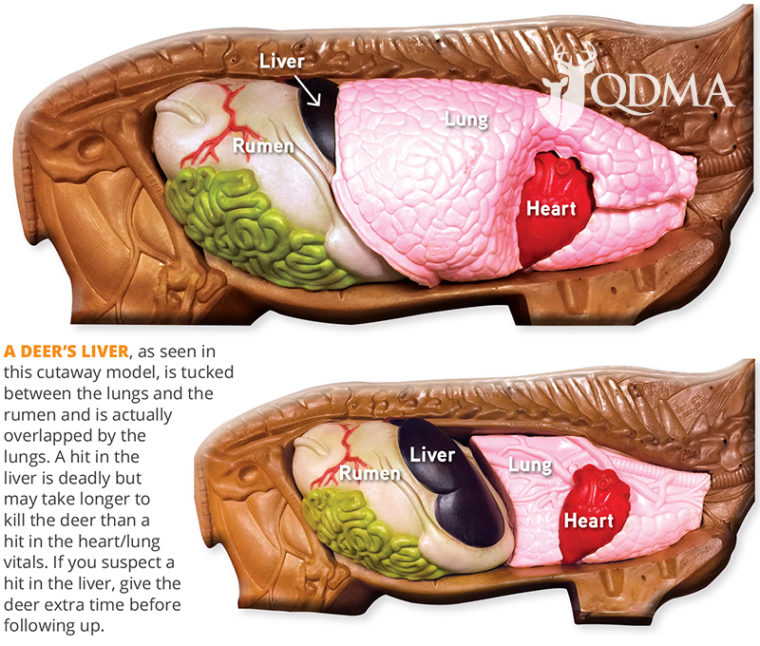
I arrived at the stand early with more than four hours until sunset. Sitting patiently, I waited for the “prime time” of the evening. Time seemed to drag, but finally I noticed the wind speed starting to slow and the sun setting behind the tree line, so I stood up to prepare myself for the long-anticipated deer movement. My eyes caught movement on the edge of the swamp in front of me. Light was already growing scarce, and my squinting eyes fought to bring the deer into focus. I turned around, grabbed my bow and fixed my gaze in the direction of the approaching deer. What I thought was tangled brush or sticks turned into ivory tines as a buck shook his head vigorously, as if he had just risen from his bed to shake the dust off. My throat began to swell as the buck moved closer. Definitely a shooter! I scanned the area in front of him where I expected him to travel. He continued down the trail through the funnel, and as his head passed behind a tree, I drew my bow and prepared for the shot. I vocalized a loud grunt to stop him, settled in on the vitals, and released my arrow.
Thwack!
The buck kicked his hind legs before running off out of sight. I sat down in my treestand to collect myself, and I attempted to focus on what had happened. The truth is, I did not see exactly where I hit this deer. All I knew was that I hit him, and based on the trajectory of the arrow, I had a feeling the arrow hit a little farther back than I would have preferred. The adrenaline rush seemed to have blurred my memory of the fine details during the moment of truth.
We spread out on our hands and knees, but we could not find a single drop. There was a sense of desperation in the air as we began to move farther apart, walking the field randomly.
I had made the shot at around 7:30 p.m. After calming down, I packed my things and returned home to round up a tracking party. With three good buddies ready to track, we returned at around 9 p.m. to the location where the shot took place. We began to comb the area where I believed I had hit the deer. No arrow. No blood. My hopes started to sink. Did I miss and hit a log or branch instead? We searched everywhere on the ground but found nothing. We elected to walk ahead and continue to search for blood since I saw the trail the buck had used to make his exit out of the funnel. Approximately 25 yards ahead, my buddy found first blood. Thank the Lord!
The tracking started off great as we were able to identify good blood on higher grasses with small drops hitting leaves on the ground. The buck was heading up the small hill toward the corn field. We continued to follow the blood trail uphill, and the buck seemed to be bleeding well. It was an easy track job until we reached the top of the hill at the edge of the corn field. We began to notice our blood trail was dwindling to just a few drops. As opposed to running through the corn, it appeared he was making a run for the creek bottom.
By this time, it was completely dark and the blood trail was starting to dwindle. We were only finding small spots of blood at this point. Standing at the top of the hill, we shined our lights across a cut field down to the woods where the creek ran. The open grass field was about 70 yards long, and with very little blood coming from the buck, I had a feeling this was going to be a long night.
We spread out on our hands and knees tracking through the cut field, but we could not find a single drop. There was a sense of desperation in the air as we began to move farther apart, walking the field randomly. We were growing impatient and getting ahead of ourselves. I was afraid we would be overlooking something, so we decided to regroup at the last blood. The quick transition from a warm October afternoon to a much lower temperature evening created dew on the grass. We finally found a drop of blood, and it had been caught by a droplet of dew and eased down to the base of the blade of grass. The dew was further complicating our track job.
It took us almost an hour to track across the cut field. We continued to find blood on blades of grass. Even though it was painstaking and tedious, we wanted to ensure that we were on this buck. Shining the light ahead we noticed the woods were close and the opening of a large trail was just ahead. We moved forward into the woods and began to notice more blood. Just a few paces onward, the blood trail opened up like a red carpet. I have never seen a blood trail like it in my life. We followed it along the bank of a creek for 20 yards until it suddenly dried up again.
Shining my light across the creek to my left I caught a shimmer of orange, and I quickly moved my light back. It was him, but he was not dead. The buck managed to lift his head weakly. We froze, gawking in complete awe of this exceptional Michigan whitetail.
“We need to get out of here,” I whispered to my tracking party.
We slowly slipped back the way we had walked in, but as soon as we left the creek bottom we started celebrating like kids on Christmas morning.
We found him on the creek at midnight, three hours after starting to track him. When we checked again at 2 a.m., the buck had expired, and we began the drag out. It was a late night, but I wouldn’t want to spend it doing anything else.
Lessons Learned
Looking back and reflecting on our tracking job, there were things we did right, things we did wrong, and there was definitely some luck involved.
Starting at the beginning, I felt that my shot was a little far back, but I did not know exactly where I hit this deer. After talking with a few guys who have shot way more deer than me, I came to the conclusion that I should have found first blood and backed out. Looking back, I believe now I should have delayed our tracking efforts until the next morning. I am sure many would agree with that, as backing out would have given the buck plenty of time to expire if the shot was lethal, and we would not risk pushing the deer further or potentially losing him altogether. We got lucky and thankfully we recovered him.
Additionally, when we were losing blood at the top of the hill and began our tracking efforts into the cut field, we started to feel discouraged and desperate for blood or sign. With a heightened feeling of uncertainty, this blood trail was really testing our patience. I believe it was these emotions that triggered us to start walking the field randomly searching. We were not at the point of giving up, but we were reaching for an indication of direction. In this situation, we were looking for a needle in a haystack. It wasn’t until we regrouped, started at last blood again and slowly moved forward that we found the next drop of blood. We wanted to recover this buck as quickly as possible. We were all excited and anxious about finding him. But these emotions can cause us to forget technique and start searching desperately, which is what happened to us.
I have been on other tracking jobs where we nearly gave up because we couldn’t find good blood, but after regrouping and slowly moving forward, we would find small, tiny drops maybe every five yards. It’s not the easiest path, but we owe it to the animal to search thoroughly but smartly and with patience. We ended up searching the cut field on our hands and knees, seemingly inspecting every blade of grass for a long time, but it was worth every minute.
We walked up on the buck when it was still alive. It was surprising to see, but he did not have much left in him. If the shot was less lethal, we could have bumped him and never seen him again. When I released my arrow, the buck was quartering away. The arrow entered high and far back, penetrating downward, but it did not pass through. The arrow fell out somewhere along the trail, but we did not find it. After processing the deer, we found it was a liver shot. But at the time, I knew nothing about that kind of shot and its effects.
The liver is tucked between the back of the lungs and the front of the rumen, right in the “a little far back” zone. It’s a lethal hit, but it is not quickly lethal like a hit in the heart/lung area. If we had waited overnight, chances are we still would have recovered the buck in the same spot. Our excitement got the best of us and we proceeded to track, and we ran the risk of bumping him. In fact, it’s possible that we did bump him and made him move at the place where the blood trail really opened up again, but we’ll never know for sure. We were very lucky the buck expired as quickly as he did.
Overall, I learned some valuable lessons on this blood trail. Success depends on the shot, and you should always do your best to make the best shot you can in the beginning to ensure a short blood trail. On those occasions when this doesn’t work out, you can never have enough patience when it comes to tracking deer. In most tracking situations where you aren’t certain you made a perfect hit or the blood trail becomes very difficult to follow, backing out and waiting is often the best decision. It is difficult to fight the emotions of excitement and curiosity, but one has to assess the situation and look at the realities of recovering a wounded animal. This experience changed the way I approach tracking, and it is something I will never forget.
About the Author: John Lyszczyk of Michigan is a QDMA member, a Level II QDMA Deer Steward and the producer and host of DieHard Bowhunter. Along with being a passionate bowhunter, he is a dedicated land and wildlife steward. He enjoys chasing whitetails in his home state of Michigan. Instagram: @diehard.bowhunter

